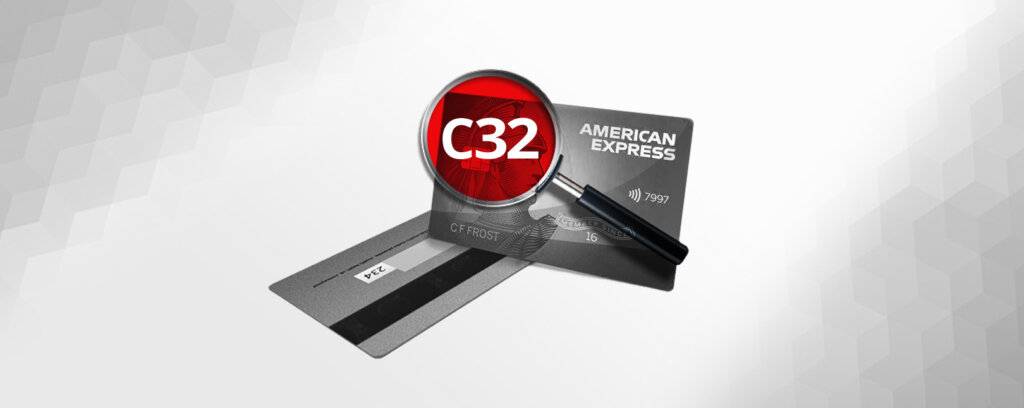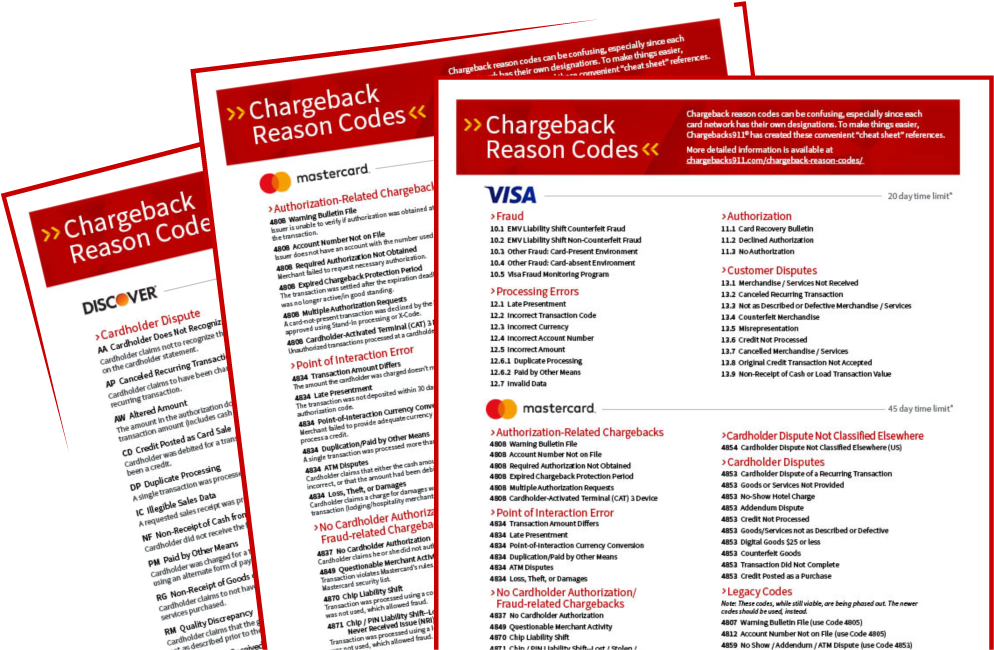
How to Handle Amex Reason Code C32 Chargebacks
American Express breaks down the acceptable causes for a customer to dispute a credit card transaction in their dispute guidelines. This is done for the sake of simplicity and standardization.
Each chargeback trigger has a designated “reason code.” Amex can then assign the appropriate code to each case to show the given reason for the chargeback.
Learn more about Amex reason codes
Today, we’re looking at one reason code in particular — C32 — and exploring the causes, timeframes, fees, and other specifics. We’ll also explore what you can do to prevent these chargebacks from happening.
Recommended reading
- Chargeback Stats: All the Key Dispute Data Points for 2025
- Credit Card Disputes | Step-by-Step Process Guide for 2025
- Mastercard Chargeback Time Limits: The 2025 Guide
- Chargebacks911® Gets in the Game for the Special Olympics!
- Chargebacks911® Food Drive in Support of The Kind Mouse!
- Can You Dispute A Dispute? Yes — Here’s What to Do
What is American Express Reason Code C32?
American Express chargeback reason code C32 is “Goods/Services Damaged or Defective.” This reason code is used to explain that the customer received the item they purchased. However, the item (or items) either did not work, or did not arrive in the condition promised.
To illustrate, imagine that a cardholder purchased an item online. The item was advertised as being in “new” condition. However, when the package arrived, it appeared to have several defects that were not mentioned by the merchant. This could entitle the buyer to a reason code C32 chargeback.
This can also be issued as a partial chargeback. For example, let’s say your customer purchased several items. However, due to improper packaging during order fulfillment, one of the items was damaged during shipping. The buyer may then request a chargeback in the amount of what was spent on the damaged item.
What Caused This Dispute?
Amex Chargeback Reason Code C32 is primarily issued when goods are shipped in a damaged or defective state, which was not explicitly mentioned to the buyer at the time of purchase. To demonstrate, this scenario can arise if:

How to Respond to Amex Reason Code C32 Chargebacks
So, what happens if you can prove that the goods you shipped to the buyer arrived in the condition that was promised at the time of purchase?
If you receive an Amex reason code C32 chargeback, but you believe the chargeback was filed without a valid reason, you're within your right to contest it. This can be done through a process called representment. It's crucial to address the matter quickly, though.
Representment allows you to contest a chargeback. You're required to submit proof to the card provider (in this scenario, American Express) that every detail of the transaction was bona fide and compliant with the card issuer's regulations. This may involve producing specific, key pieces of evidence (more on this below).
Don't lose sight of the strict deadline, though. You have just 20 days in which to submit your response to American Express. This includes the time taken by your acquirer to offer you a dispute notice, and the effort invested by the acquirer in examining and submitting your case. In realistic terms, this could mean you commonly have five days or less to prepare and present your defense.
Acceptable Evidence for Amex Reason Code C32 Responses
As mentioned above, you can re-represent these charges under the condition that you have compelling evidence.
For American Express reason code C32 chargebacks, you’ll need to provide proof refuting the cardholder’s claim that the goods or services were damaged or defective. This may include:
- A copy of the item description as it appeared on the product page at the time of purchase, detailed the condition of the item purchased.
- A copy of your terms and conditions, outlining expectations for the buyer.
- Proof that the buyer proactively agreed to the terms and conditions you provided before completing the purchase.
- High-res photos of the specific item that was shipped to the buyer, showing it from multiple angles.
- Copies of emails or transcripts of phone calls between yourself and the buyer.
Alternatively, you might have already issued a credit to the buyer as a way of trying to avoid the dispute. In this case, you’ll need to offer proof that you already provided a credit to offset the amount charged.
The success of representment depends on the thoroughness and relevance of the evidence provided. Maintaining detailed records of transactions and communications with customers is vital to effectively counteract all chargebacks, including those under American Express reason code C32.
How to Prevent Amex Reason Code C32 Chargebacks
As the old adage goes, “an ounce of prevention is worth a pound of cure.”
You may never be able to stop chargebacks entirely. But, you can limit your exposure to risk and keep your chargeback ratio in good standing by adopting a few best practices. Generally speaking, you’ll want to:
#1 | Securely Package Goods
Ensure that all merchandise is securely packaged, with proper insulation and a sturdy box. This will prevent damage from occurring during the shipping process.
#2 | Address Customer Complaints Quickly
Move fast to rectify or resolve any complaints about damaged or defective merchandise. Aim to respond to customer inquiries via email within one hour.
#3 | Provide Return Authorization
Seek authorization before completing a product refund request (if your purchase terms or policies permit).
#4 | Be Prompt in Issuing Credits
Move fast to issue credits, or to offer to replace damaged or defective goods. Provide a projected date on which the cardholder should expect to receive their credit or replacement item.
#5 | Make Your Policies Easy to Find
Post your return policies in a visible location. On your site, ensure they’re accessible from every page, and that there’s a prominent link to them on every product page and on your checkout page.
#6 | Provide Excellent Customer Service
Your customer will already be irritated by receiving damaged or defective goods. You can help defuse the situation by providing responsive, empathetic customer service.
Take a Wider View
You can dispute invalid chargebacks from Amex reason code C32. However, it’s much more efficient to take a proactive stance. The same is true of the other chargeback reason codes, as well. A truly effective chargeback management strategy must encompass prevention as well as disputing cases of friendly fraud.
Chargebacks911® can help your business manage all aspects of chargeback reason codes, with proprietary technologies and experience-based expertise. Contact us today for a free ROI analysis to learn how much more you could save.
FAQs
Does Amex investigate chargebacks?
Yes. American Express investigates chargebacks by reviewing the evidence provided by both the merchant and the cardholder to determine the legitimacy of the transaction and decide on the chargeback claim. This process ensures a fair resolution based on the documentation and arguments presented by both parties.
What is the reason code for a chargeback on American Express card?
An American Express chargeback reason code is a code that identifies the specific reason a cardholder or issuing bank has disputed a transaction, guiding the merchant on the nature of the dispute and what evidence may be required to contest it. Each code corresponds to a particular issue, such as unauthorized use, processing errors, or non-receipt of goods or services. Click here to see a full list of Amex reason codes.
Do police investigate chargebacks?
Police typically do not investigate chargebacks as they are considered a dispute between the merchant and the cardholder, handled through the card issuer's internal processes. However, if fraud is suspected as the cause of a chargeback, law enforcement may be involved in investigating the fraudulent activities.
How successful are Amex disputes?
The success of an American Express dispute depends on the merchant's ability to provide compelling evidence that the transaction was valid and in accordance with Amex policies. Success rates vary widely based on the nature of the dispute and the quality of the documentation provided by the merchant.
How does American Express investigate disputes?
American Express investigates disputes by reviewing documentation and evidence provided by both the cardholder and the merchant, such as transaction receipts, proof of delivery, or communication records, to determine the validity of the chargeback claim. This process aims to ensure a fair resolution based on the facts presented by both parties.









